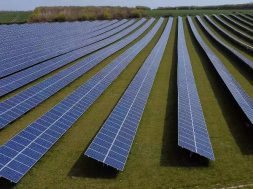
Heraeus Sees a Bright Future for Renewable Energy in China
Heraeus, a leading technology supplier for the renewable energy industry, expects technology advancements and greater adoption in China to eventually make renewable energy cheaper to produce than any other energy source. The company shared its vision and the leading role China will play at this year’s International SNEC – Photovoltaic Power Generation Conference in Shanghai.
According Andreas Liebheit, President Heraeus Photovoltaics, “China has developed to the global driver for renewable energies. From technology to education, they are perfectly positioned to capitalize on the major trends that will drive the region for the next several decades.” These include: Microgrids, smart electricity management and storage solutions, innovations to further drive efficiency of renewable energy systems and to make renewable energy applicable in global city centers. “By combining these trends, Heraeus is convinced that the levelized costs of renewable energy will be able to decrease by 50% every five years“, Liebheit continued.
China is already playing a leading role in the implementation leadership of nearly 300 microgrids in 26 provinces. These decentralized, self-sufficient power networks can integrate renewable energy sources to generate grid-quality electricity while decreasing overall energy transport costs. Additionally, 28 “Smart City” pilot projects have been implemented in Beijing and Shanghai, serving 30,000 households.
Heraeus believes that these examples of smart energy plannings will provide a blueprint for the public and private sector to increase renewable energy adoption, particularly with new constructions.
Additionally, Heraeus is calling for universities and the construction profession to include renewable energies in curriculums and increase education and training in renewable energy systems. As the renewable energy industry is expected to grow strongly and as China is planning to increase industrial job qualification in its “Made in China 2025”prgramme, the industry in China will need a “workforce of the future” also in the renewable energy sector.
Smart energy concepts will become widely available.
Advancements in big data will enable energy consumption to become precisely predictable, from a single household to a city district to a factory. Combined with new sources of renewable energy production (such as homes, skyscrapers and even cars) smart usage and trading of electricity will enable individuals and businesses to become energy producers and dealers. Innovations in energy storage will allow individuals and businesses to better utilize or trade excess power generated through their renewable energy systems.
Heraeus believes that output of PV modules will increase by 60% until 2030, bringing up a standard 60 cell module to over 500W.
While PERC (Passivated Emitter and Rear Cell) technology and Tandem cells are already entering the market, allowing to convert all wavelengths of sunlight into energy, new and semi-transparent materials will permit alternative designs of Photovoltaics. This will allow the industry to build ultra-efficient modules that will reduce the price per KW/h significantly and to increase output of standard modules by 60% until 2030. Heraeus is one of the pioneers supporting PERC technology and today has a leading positioning supply PERC paste.
Conductive polymers will furthermore become a significant part of Photovoltaic layouts. As they are transparent, conductive polymers will be able to be integrated in windows, in cover panels for all types of buildings and even for shadow casted areas of houses. Heraeus’ research in conductive polymers has shown that efficiency gains of around 15% could be achieved with this technology in mass production. Costs of using conductive polymers will be incredibly low as they are applied in a standard printing process.
Battery and hydrogen-based technology will provide new storage solutions to significantly increase renewable energy adoption.
Battery technology will play an important role in the short-term. Heraeus expects battery costs to drop 20% a year to below 150 USD/kWh in 2020. Battery farms and batteries in every building will help form integrated regional and global networks that will drive energy generation. Next-generation vehicles will utilize battery technology to form a massive and flexible electricity storage cloud.
Heraeus also predicts that from a longer-term perspective, hydrogen will become the backbone of national energy reserves in China and other leading nations. Based on promising research in hydrogen fuel cell technology, fuel cells will be used in all transport vehicles, such as light and medium trucks, heavy trucks, buses, ships and even trains. As hydrogen as energy source increases in adoption, fuel cell factories will become the power plants of the future and could easily utilize part of the existing gas infrastructure.
“Renewable energy is competitive today and will become the most cost effective source of energy,” says Andreas Liebheit, President of Heraeus Photovoltaics. “Heraeus innovation roadmap is fully focused on this and we are will be able to increase efficiency by at least 0.2% per year”.












